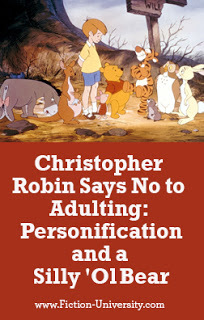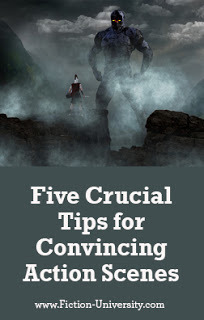Janice Hardy's Blog, page 96
September 16, 2018
Writing Prompt: The Photo Prompt: Into the Woods?
By Janice Hardy, @Janice_Hardy
This week’s prompt is a photo prompt. Write whatever comes to mind, be it a description, a story, or even a poem.
Write something inspired by this photo.
 Written by Janice Hardy. Fiction-University.com
Written by Janice Hardy. Fiction-University.com
This week’s prompt is a photo prompt. Write whatever comes to mind, be it a description, a story, or even a poem.
Write something inspired by this photo.
 Written by Janice Hardy. Fiction-University.com
Written by Janice Hardy. Fiction-University.com
Published on September 16, 2018 05:03
September 15, 2018
Real Life Diagnostics: Does This Opening Bore or Interest You to Read More?

Critique By Maria D'Marco
Real Life Diagnostics is a weekly column that studies a snippet of a work in progress for specific issues. Readers are encouraged to send in work with questions, and we diagnose it on the site. It’s part critique, part example, and designed to help the submitter as well as anyone else having a similar problem.
If you're interested in submitting to Real Life Diagnostics, please check out these guidelines.
Submissions currently in the queue: Zero
Please Note: As of today, RLD slots are open.
This week’s question:
1. Does this opening bore or interest you to read more?
Market/Genre: Women's Fiction
This is a resubmit. If you're curious to see how the author revised, here's the previous version.
On to the diagnosis…
Written by Janice Hardy. Fiction-University.com

Published on September 15, 2018 06:11
September 14, 2018
Christopher Robin Says No to Adulting: Personification and a Silly 'Ol Bear
 By Natalie Odisho
By Natalie OdishoLet’s Get Lit: Spotlight on Allegory
Why the new adventure of Christopher Robin brings life in and out of the Hundred Acre Wood.
Did you know that Winnie-the-Pooh started as one adult’s solution to sleepless nights? Christopher Robin was named after English author A.A. Milne’s son, Christopher Robin Milne, who needed
bedtime stories to fall asleep.What originally began as a childhood story has grown to become a pastime for the world to enjoy. Today, Winnie-the-Pooh is one of the most successful, celebrated children’s stories in history.
Now a major motion picture, Christopher Robin retells a childhood classic through the eyes of an adult. As storytellers, A.A. Milne and Disney sprinkle the magic of childhood through personified stuffed animals with language, clothing and temperament.
Written by Janice Hardy. Fiction-University.com

Published on September 14, 2018 03:00
September 12, 2018
Are You Making This Character Flaw Mistake?
 By Janice Hardy, @Janice_Hardy
By Janice Hardy, @Janice_Hardy “Give your characters flaws” is one of the more common pieces of writing advice out there. It’s good advice, as flaws make characters more human and relatable, and the fatal flaw is a critical part of any character arc, but many writers make an easy mistake when creating them.
They think flaws have to be negative traits.
In many stories, the flaw is a negative trait that must be overcome, but it’s not always the case. And when it isn’t, the belief that all flaws are “bad” can cause a lot of frustration for a writer trying to find a plausible reason why the protagonist has a negative flaw that fits the plot, story, and character arc.
A good example here is the flaw in my current WIP—my protagonist cares about people too much.
Wait…what? Did you say she cares? How could that possibly be a flaw?
Written by Janice Hardy. Fiction-University.com

Published on September 12, 2018 05:29
September 11, 2018
5 Tips for Writing Group Success
 By Laurence MacNaughton, @LMacNaughton
By Laurence MacNaughton, @LMacNaughton Part of the How They Do It Series (Contributing Author)
Thinking about joining a writing group, or starting your own? A supportive and insightful group can help you become a better writer and put you on the path to getting published. But a disorganized group can squelch your enthusiasm to write and leave you feeling confused. To stop the writing group headaches before they began, follow these crucial tips.
1. Choose (or start) a group that specializes in your genre.
One of the biggest mistakes most writing groups make is embracing every form of writing you can think of: essays, screenplays, nonfiction, poetry, romance novels, you name it.
Written by Janice Hardy. Fiction-University.com

Published on September 11, 2018 04:33
September 10, 2018
The WRITE-PUBLISH-PROFIT SUPER STACK Bundle is Back (But only for a few days)

By Janice Hardy, @Janice_Hardy
A while back, I came across a great compilation of resources for writers and self-publishers. It included over $3,000 worth of premium resources, from ebooks and courses, to huge discounts on writer services, and more, all for under $50.
The deal only lasted 7 days and then it was gone, but due to overwhelming demand, the deal is back and its live right now! Even better, this time, I've added one of my own books, and you can get Fixing Your Character and Point of View Problems as part of this bundle.
Click here to check it out!
Besides my book, you'll also find premium resources and tools from 35 + highly successful writers, publishers and thought leaders.
Here’s a quick list of just some of the info that’s included:
Written by Janice Hardy. Fiction-University.com

Published on September 10, 2018 07:00
The Indie Publisher’s Toolbox – Part 1
 By Ray Flynt
By Ray Flynt(Part of the Indie Author Series)
Due to a bit of a scheduling mishap last week, here's an extra Indie Author article on the tools you'll need to be successful to get your week started. Though this advice is good for any author no matter which publishing path they take.
Previously we examined the topic of “writer as entrepreneur.” Although this is called the Indie Author Series it’s really about being an Indie Publisher. You’ll find lots of tools and helpful hints here at Fiction University about being a better writer from how to make your stories more compelling to techniques for proofreading. You’ve written a great book. It’s time to make the world beat a path to your door.
If you were building (let’s think modestly) a dog house, you’d have a pretty good idea of the tools you’d need to accomplish the job: plywood, nails and/or screws, a saw, a hammer, a square, and an appropriate cover for the roof. Throw in a blanket and set a water bowl out front and voila -a dog house.
Written by Janice Hardy. Fiction-University.com

Published on September 10, 2018 04:39
September 9, 2018
Writing Prompt: The Chain Story: A Lousy Invention?
 By Janice Hardy, @Janice_Hardy
By Janice Hardy, @Janice_HardyThis week’s prompt is a chain story! I’ll give you the first line, and someone else comments and builds off that line. Next commenter will build off that line, and so on.
In the event of two commenters posting at the same time and sending the story in different directions, just pick the line you like best, or try to incorporate both if you can.
Whoever invented chocolate-covered coffee beans was either a genius or a madman.
Let the fun begin.
Written by Janice Hardy. Fiction-University.com

Published on September 09, 2018 04:30
September 8, 2018
Real Life Diagnostics: Is This Narration Confusing?
 Critique By Janice Hardy, @Janice_Hardy
Critique By Janice Hardy, @Janice_HardyReal Life Diagnostics is a weekly column that studies a snippet of a work in progress for specific issues. Readers are encouraged to send in work with questions, and we diagnose it on the site. It’s part critique, part example, and designed to help the submitter as well as anyone else having a similar problem.
If you're interested in submitting to Real Life Diagnostics, please check out these guidelines.
Submissions currently in the queue: One
Please Note: As of today, RLD slots are booked through September 15.
This week’s questions:
Can I jump around in time (and some POV) in a short story?
The narration has both present and past tense. Does this confuse the reader?
Does the title work as a play on the day and the outcome to the story?
Am I asking the reader to intuit and deduce too much. For example, the man wants to kill himself on a Sunday because that is the day his wife died? The wife helped the man make decisions, and he recalls her words because of the sunshine, and that forces him to make a decision. Too much?
Market/Genre: Short Story
On to the diagnosis…
Written by Janice Hardy. Fiction-University.com

Published on September 08, 2018 05:41
September 7, 2018
Five Crucial Tips for Convincing Action Scenes
 By Harrison Demchick, @HDemchick
By Harrison Demchick, @HDemchick Part of the How They Do It Series
JH: Action scenes can be tough to write, since they're often a lot of description to describe a single act. Harrison Demchick visits the lecture hall today to share some tips on writing a convincing action scene. He's also offering a free compelling action checklist on his website, so be sure to check that out.
Take it away Harrison...
You’ve finally worked your way to the climax of your novel, and you’re thinking big. Lasers. Explosions. An avalanche in the middle of a hurricane. Basically the end result of a Marvel-sized movie budget flowing from the tips of your fast-typing fingers.
That’s great—but let’s slow down a little. Great action in fiction doesn’t come from size and scope alone. Effective action is crafted with care. As a book editor, I’ve worked on scenes as massive as a dozen or more superhuman teenagers battling it out with a litany of impossible powers, and scenes as small and well-considered as a heated argument in a confined space—and I’ve also seen all of these scenes fumble and fail for one reason or another.
Written by Janice Hardy. Fiction-University.com

Published on September 07, 2018 05:18



